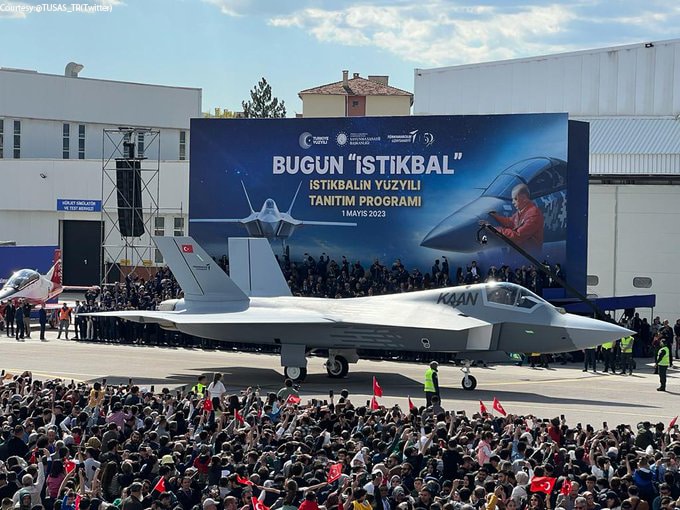Aerospace
Pakistan might be interested in replacing its F16 aircraft with a KAAN 5th gen fighter from Turkey.

Pakistan believes that Turkey’s First Fifth Generation Fighter will replace the F-16.
The air force in Pakistan is eager to replace its aging fleet. It has repeatedly asked the United States for upgrades to its F16 fleet, but the United States has refused due to pressure from its neighbors and some allies, including China.
Later, Pakistan forcibly acquired the newest fighter jet from China, the J-10, for its fleet despite being uncertain of the aircraft’s intended use. and some aircraft were constructed in Pakistan.
US approves sale of an F16 fighter jet to Pakistan(Opens in a new browser tab)
Now It is crucial for Pakistan to upgrade its air force fleet with the latest aircraft so that it has the option to choose Turkish defense manufacturing. The Turkish Air Force just got its first F-16 fighter plane that was upgraded locally. As part of Turkish Aerospace Industries’ Project Ozgur, the aircraft has been modernized. Pakistan also may get similar assistance to upgrade its fleet in the upcoming days.
When Turkey’s first fifth-generation fighter, the TAI Kaan, completes its developmental trials around 2030, Pakistan has indicated an interest in purchasing it from Turkish Aerospace Industries (TAI).
Pakistan currently has its sights set on the Turkish KAAN fighter jet, which was just completed and is rumored to be a fifth-generation fighter. Additionally, it displayed some of the aircraft’s features and perspective, which are somewhat reminiscent of those of the US F22 and Russian Su 57.
How will be the Tejas Mark 2 compared to the F-16 block 50/52?(Opens in a new browser tab)
Pakistan may variety of options with Turkey. even it can ask for the domestic production of the Turkish fighter jet and also it can import most of the weapons. Turkish is also willing to make the agreement with Pakistan, it is already looking for buyers for its newly developed products.
Turkish engineers hope to make their fifth-generation aircraft more competitive with the US F35 or the Russian Su-57. However, it will take some time as the Turkish manufacturing industry’s biggest problems are the engines and avionics, which they are always working to resolve.
Currently, Turkey manages the majority of aircraft, although it is working to acquire engines, many of which may come from Rolls-Royce for its KAAN TFX fighter.

Aerospace
Boeing Transfers Rocket Stage to NASA, Paving Way for Human Moon Mission

Boeing has achieved a significant milestone by providing NASA with the second core stage of the Space Launch System (SLS) rocket.
This crucial component, crafted at NASA’s Michoud Assembly Facility (MAF), is set to propel the Artemis II crew into lunar orbit, marking humanity’s return to deep space after a 50-year hiatus.
The monumental Boeing-built rocket stage, the largest element of the Artemis II mission, will embark on a journey aboard the Pegasus barge, traveling 900 miles to NASA’s Kennedy Space Center.
Comparison of two legendary aircraft B777x vs B747 aircraft:Click here
Upon arrival, it will be meticulously integrated with other essential Artemis II components, including the upper stage, solid rocket boosters, and NASA’s Orion spacecraft within the iconic Vehicle Assembly Building. This intricate integration process is a vital step toward the eagerly anticipated Artemis II launch, slated for 2025.
“Boeing-built products helped land humankind on the moon in 1969, and we’re proud to continue that legacy through the Artemis generation,” remarked Dave Dutcher, vice president and program manager for Boeing’s SLS program. “Together, with NASA and our industry partners and suppliers, we are building the world’s most capable rocket and paving the way to deep space through America’s rocket factory in New Orleans.”
NASA, Lockheed Martin Reveal X-59 Quiet Supersonic Aircraft:Click here
The delivery of Core Stage 2 marks a significant achievement in the evolution of the SLS rocket. Towering over 200 feet and powered by four RS-25 engines, this core stage, coupled with two solid-fueled booster rockets, will generate a staggering 8.8 million pounds of thrust. This immense power is crucial to launching Artemis II and future missions into the vast expanse of space.
The SLS rocket stands unparalleled in its capability to transport both crew and substantial cargo to the moon and beyond in a single launch. Its extraordinary capacity will facilitate the delivery of human-rated spacecraft, habitats, and scientific missions to destinations including the moon and Mars, ushering in a new era of space exploration.
-

 Travel1 week ago
Travel1 week agoAir India to Expand US Operations with Three New Routes After a Decade
-

 Travel2 weeks ago
Travel2 weeks agoWhy We Should Avoid These Stamps in a Passport
-

 Airlines1 month ago
Airlines1 month agoInvestigations Reveal Fake Chinese Titanium in Boeing and Airbus Jets
-

 Tech4 weeks ago
Tech4 weeks agoChina’s CATL Plans 1,800-Mile Electric Plane Launch by 2027
-

 Airport3 days ago
Airport3 days agoTop 10 Largest Airports in the World by Size
-

 Aerospace4 weeks ago
Aerospace4 weeks agoChina’s Fighter Jets Turn Wings into Autonomous Drones
-

 Airlines4 days ago
Airlines4 days agoAir India Rolls Out A350s for Delhi-New York JFK and Newark Routes
-

 Defence3 weeks ago
Defence3 weeks agoBoeing Enhances Chinook with New Engines and Block II Upgrades at $96 Million







